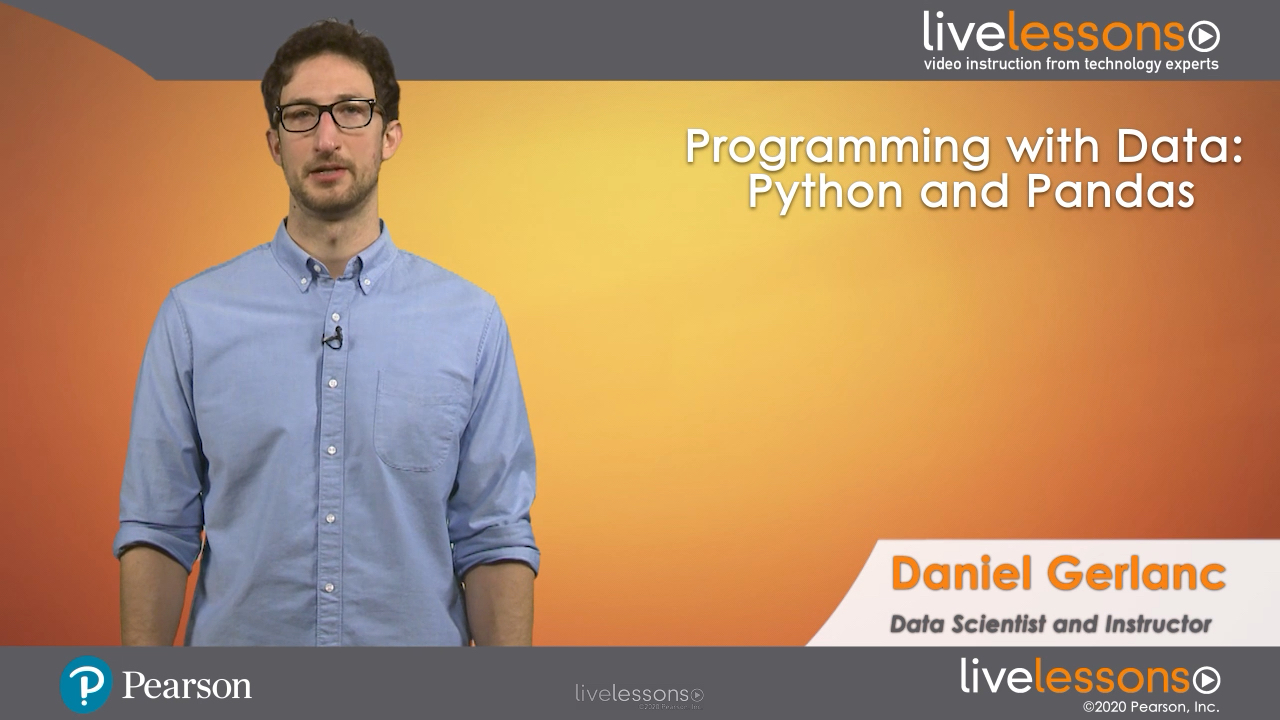Programming with Data: Python and Pandas LiveLessons (Video Training)
- By Daniel Gerlanc
- Published Feb 21, 2020 by Addison-Wesley Professional.
Online Video
- Your Price: $199.99
- List Price: $249.99
- About this video
Video accessible from your Account page after purchase.
Register your product to gain access to bonus material or receive a coupon.
Description
- Copyright 2020
- Edition: 1st
- Online Video
- ISBN-10: 0-13-662374-3
- ISBN-13: 978-0-13-662374-8
5 Hours of Video Instruction
Learn how to use Pandas and Python to load and transform tabular data and perform your own analyses.
Overview
In Programming with Data: Python and Pandas LiveLessons, data scientist Daniel Gerlanc prepares learners who have no experience working with tabular data to perform their own analyses. The video course focuses on both the distinguishing features of Pandas and the commonalities Pandas shares with other data analysis environments.
In this LiveLesson, Dan starts by introducing univariate and multivariate data structures in Pandas and describes how to understand them both in the context of the Pandas framework and in relation to other libraries and environments for tabular data like R and relational databases. Next, Dan covers reading and writing to external file formats, split-apply-combine computations, introductory and advanced time series, and merging and reshaping datasets. After watching this video, Python programmers will gain a deep understanding of the Pandas framework through exposures to all of its APIs and feature sets.
Skill Level
- Beginner
- Intermediate
Learn How To
- Avoid common pitfalls and “gotchas” in Pandas by understanding the conceptual underpinnings common to most data manipulation libraries and environments
- Create univariate (Series) and multivariate (DataFrame) data structures in Pandas
- Read from and write to external data sources like text and binary files and databases
- Use the Split-Apply-Combine technique to calculate grouped summary statistics like mean, median, and standard deviation on your data
- Handle time series data; apply lead, lag, and rolling computations to them; and interpolate missing data
- Merge and reshape datasets
- Understand how data alignment is a central concept of Pandas
Who Should Take This Course
- People with a solid understanding of Python programming who want to learn how to load and transform tabular data using Pandas and understand general principles and requirements common to tabular data manipulation frameworks
Course Requirements
- Intermediate-level programming ability in Python. You should know the difference between a dict, list, and tuple. Familiarity with control-flow (if/else/for/while) and error handling (try/catch) are required.
- No statistics background is required.
About Pearson Video Training
Pearson publishes expert-led video tutorials covering a wide selection of technology topics designed to teach you the skills you need to succeed. These professional and personal technology videos feature world-leading author instructors published by your trusted technology brands: Addison-Wesley, Cisco Press, Pearson IT Certification, Prentice Hall, Sams, and Que Topics include: IT Certification, Network Security, Cisco Technology, Programming, Web Development, Mobile Development, and more. Learn more about Pearson Video training at http://www.informit.com/video.
Video Lessons are available for download for offline viewing within the streaming format. Look for the green arrow in each lesson.
Sample Content
Table of Contents
Introduction
Lesson 1: Series
Learning objectives
1.1 Install Python and Pandas
1.2 Learn two ways to conceptualize a Series
1.3 Create and examine a Series
1.4 Select from a Series
1.5 Write vectorized queries against a Series
1.6 Handle missing data in Pandas
Lesson 2: DataFrames
Learning objectives
2.1 Learn different conceptualizations of a DataFrame
2.2 Create a DataFrame
2.3 Select only columns or rows from a DataFrame
2.4 Select both rows and columns of a DataFrame
2.5 Modify a DataFrame in place
2.6 Align and add a column to a DataFrame
Lesson 3: Reading and Writing External Data
Learning objectives
3.1 Read data from text files, e.g. CSV
3.2 Read data from binary files
3.3 Read data from a database
3.4 Write data to CSV and other text files
3.5 Write data to parquet format
3.6 Write data to a database
Lesson 4: Split-Apply-Combine
Learning objectives
4.1 Understand the theory of split-apply-combine
4.2 Split data by groups
4.3 Apply and reduce by group
Lesson 5: Time Series
Learning objectives
5.1 Create a time series
5.2 Select from a time series
5.3 Perform lead and lag operations
5.4 Resample a time series
5.5 Fill and interpolate missing data
5.6 Align time series
5.7 Apply rolling calculations
Lesson 6: Merging and Joining
Learning objectives
6.1 Learn different types of joins
6.2 Use merge for general purpose joins
6.3 Understand append and concat
6.4 Perform advanced merges
Lesson 7: Reshape and Pivot
Learning objectives
7.1 Understand the concept of reshaping
7.2 Perform wide to long and long to wide reshaping
7.3 Learn convenience methods for reshaping
7.4 Create pivot tables
Lesson 8: Alignment as a Central Concept of Pandas
Learning objectives
8.1 Create a standalone index
8.2 Create a MultiIndex
8.3 Use align and reindex
Lesson 9: Advanced Time Series
Learning objectives
9.1 Create a custom calendar
9.2 Understand time zone considerations
Summary
More Information

